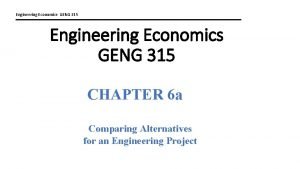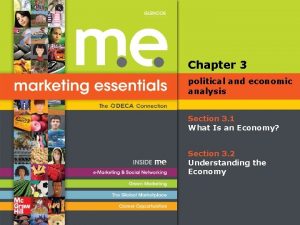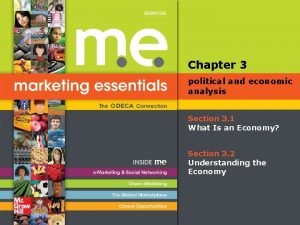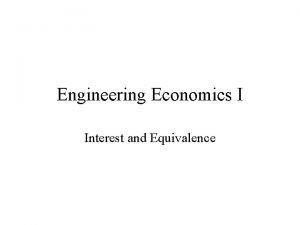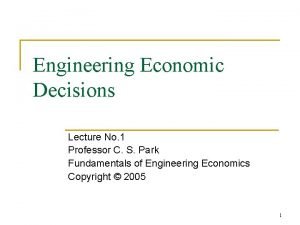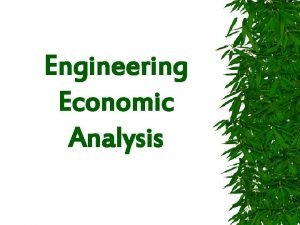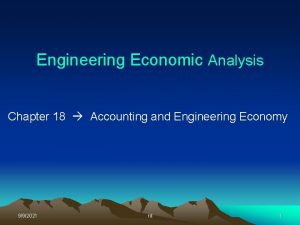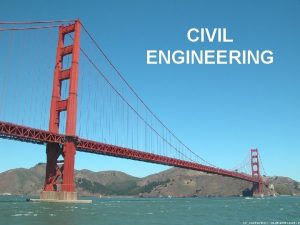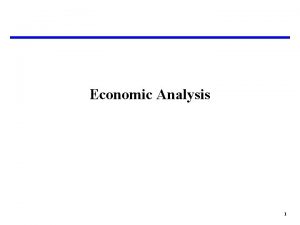Engineering Economic Analysis Chapter 16 Economic Analysis in











- Slides: 11

Engineering Economic Analysis Chapter 16 Economic Analysis in the Public Sector 12/5/2020 rd 1

Investment Objective Promote the General Welfare Dam – loss of land upstream due to backed up water loss of arable farm land concerns of environmentalists downstream consequences Town rose garden – parking, traffic flow consequences, noise abatement, aphids Mall COMPROMISE Eminent domain … the benefits to whosoever they accrue 12/5/2020 rd 2

View Point External consequences – ignored during the past Town vs. State or Federal governments Example: A municipal project costs $1 M with the federal government putting up 50% of the cost. Accrued benefits to the town are $750 K for $500 K cost. Overall cost benefit < 1 => should not fund. Viewpoint should include those who pay and those who benefit. 12/5/2020 rd 3

Interest Rate No time value of money, Money spend as soon as printed or collected => 0%. General obligation municipal bonds – government asssted Revenue bonds – not supported by tax authority. Rate should be the highest of cost of capital, government opportunity cost, or taxpayer's opportunity cost. 12/5/2020 rd 4

Project Politics Read text page 508 -509. 12/5/2020 rd 5

Benefit/Cost Ratios Conventional = benefits / costs vs. Modified = (benefits – disbenefits)/ first-cost Interest rates Project duration Politics 12/5/2020 rd 6

16 -10 Initial cost = $100 K end of year 1 $150 K, years 2 -10 20 K B/C = [20 K(P/A, 7%, 9) (P/F, 7%, 1)]/(100 K + 150 K(1. 07)-1 121780. 04 / 240186. 92 = 0. 5070 12/5/2020 rd 7

16 -11 (PWB)2 – 22(PWC) + 44 = 0 Find PWC for optimal size project. Let x = PW of costs and y = PW of benefits y 2 -22 x + 44 = 0 or implicitly differentiating 2 yy' – 22 = 0 => y' = 11/y = 1 => y = 11 => x = 7. 5 22 x = 165 => x = 7. 5 12/5/2020 rd 8

16 -15 Benefits = Costs = (550 K - 35 K)(P/A, 8%, 20) (750 K + 2, 750 K) + 185 K(P/A, 8%, 20) = 0. 9510 Try at least 25 years in calculation to get B/C = 1. 004 Mayor is playing politics. 12/5/2020 rd 9

16 -26 Life = 15 First Cost Ann Savings Ann costs Salvage A 9. 5 K 3. 2 K 1 K 6 K B 18. 5 K 5 K 2. 75 K 4. 2 K C MARR = 12% 22 K 9. 8 K 6. 4 K 14 K a) Conventional B/C Eliminate B A B C PW Numerator 21. 7947 34. 054 66. 746 PW Denominator 15. 215 36. 463 63. 032 1. 43 0. 93 1. 06 B/C Ratio B/CC-A = 44. 95/ = 0. 94 => A is best. 12/5/2020 rd … continued 10

16 -26 continued Modified B/C Life = 15 First Cost Ann Savings Ann costs Salvage A 9. 5 K 3. 2 K 1 K 6 K B 18. 5 K 5 K 2. 75 K 4. 2 K C MARR = 12% 22 K 9. 8 K 6. 4 K 14 K A B C 14. 984 15. 324 23. 157 PW Denominator 8. 404 17. 733 19. 142 B/C Ratio 1. 78 0. 86 1. 19 PW Numerator B/CC-A = 8. 173/10. 738/ = 0. 76 => A is best. 12/5/2020 rd 11
 Engineering economic analysis procedure
Engineering economic analysis procedure Economic growth vs economic development
Economic growth vs economic development Growth and development conclusion
Growth and development conclusion Chapter 1 lesson 2 our economic choices worksheet answers
Chapter 1 lesson 2 our economic choices worksheet answers Chapter 3 political and economic analysis
Chapter 3 political and economic analysis Chapter 3 political and economic analysis
Chapter 3 political and economic analysis Economics of engineering
Economics of engineering Engineering economic decisions
Engineering economic decisions System architecture example
System architecture example Forward engineering and reverse engineering
Forward engineering and reverse engineering Engineering elegant systems: theory of systems engineering
Engineering elegant systems: theory of systems engineering Engineering elegant systems: theory of systems engineering
Engineering elegant systems: theory of systems engineering
